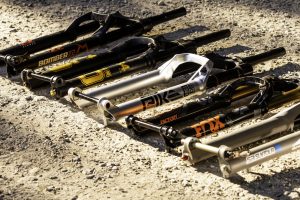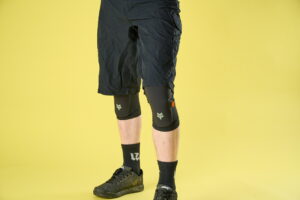High-tech meets high-value; the Sonder Evol is a budget alloy enduro bike with a posh wireless drivetrain.
Sonder’s Evol is a good back-to-basics enduro bike, but adding wireless gears puts it in the ring with some heavy hitting competition
Sonder Bikes has grown out of the Alpkit stable, where affordability meets good design and rugged build-quality in outdoor equipment. The comprehensive range now runs to 14 different bikes, from the original Transmitter hardtail, through fancy titanium gravel bikes, eccentric tandem mountain bikes, and no-nonsense trail and enduro bikes such as the Evol, tested here. One of our testers, Shaun White, had a Signal on longterm test last year and loved it.
Sonder Evol need to know
- Alloy-framed enduro bike from outdoor specialists Alpkit
- 160mm travel front and rear and MX wheels (29in front, 27.5in rear)
- GX Eagle Transmission with wireless shifting
- Customise your bike and upgrade components at point of purchase
- Two colours and four frame sizes to choose from
- Order online and get it delivered for £29.99, or pick up in-store from across the UK for free

The Sonder Evol comes in two colour options, blue and orange.
All Sonder models are overseen by Neil Sutton, a born-and-bred Yorkshireman who cut his teeth riding BMXs in the scraps of wasteland between Rotherham and Doncaster. The Evol is the brand’s hardest hitting bike, with 160mm travel front and rear, coupled with aggressive geometry. But its real selling point is the highly competitive price and the flexible sales approach, which gives riders the opportunity to customise the spec depending on the size of their wallet. In the case of the Evol, the basic price starts at just £2,299, with the luxury of SRAM’s wireless AXS shifting available from just £3,449.

But the paint is not the highest quality – this is from heel rub after just a couple of rides.
The test bike I’ve been riding has been treated to further upgrades – something anyone can do by selecting them at the check-out – which includes top-spec RockShox suspension and factory tubeless set-up. All of which bumps the price up to £4,243.97. Still a decent price, but enough of a hike to put it in the sights of some serious competition from the likes of direct-sales rivals YT, Canyon, Commencal, Privateer and Propain. In fact Jamie tested the YT Capra and Canyon Torque Mullet last year and came away extremely impressed with both.
So how does it stack up against the best enduro bikes on the market? Let’s find out.

The tube shaping from the hydroforming process is obvious, but it’s not as slick as some modern alloy bikes.
Frame and geometry
This is the second generation of the Sonder Evol, and there have been considerable changes from the original version. Yes, it still uses a hydroformed and custom butted 6061 alloy frame, with the same basic four-bar suspension layout, but the new version moves from a full 29er to an MX wheel configuration with a 27.5in hoop out back. Travel has also been boosted by 20mm front and rear to 160mm, taking its intended use from trail all-rounder to more aggressive enduro rig. While the sizing is unchanged across the four frame sizes, there have been tweaks to the geometry to make it more modern. The head angle has been nudged back from 65º to 64.5º and the seat angle has been steepened from 75.5º (effective) to 76.3º. To accommodate the smaller rear wheel, the BB drop has been reduced, and the chainstay length has also been chopped down by 10mm.

With the upgraded piggyback shock, clearance for a bottle is seriously impeded. It only just squeezes in, and it wore through the paint as a result.
There’s a decent spread of sizes on offer, with the small getting a 435mm reach and said to suit riders from 158cm, while the XL’s 505mm reach is aimed at riders of 187cm and over. At 178cm I slotted onto the size large, with 480mm reach and 440mm seat tube equipped with a 150mm dropper post.
When I measured my test bike, there were a few small discrepancies. The head angle was slacker than claimed at 63.9º, the effective seat angle at my saddle height was 75.5º, and the reach was a touch smaller than quoted at 477mm. While Sonder prints BB drop rather than BB height – to avoid variations if tyre specs change – the 345mm height is pretty average. At 15.39kg, my test bik is at the lighter end of the enduro bike scale, partly due to running the lighter Lyrik chassis. Perhaps the most significant difference between Sonder’s figures and my measurements was the travel. I measured 152mm of vertical wheel travel at the back because the RockShox Super Deluxe shock delivered a smidge less stroke than claimed.

That chainstay protector is built like a Yorkie bar, and really effective at silencing chain slap.
The new frame is certainly sleeker than the old one, particularly around the forged parts like the dropouts, chainstay yoke, and linkage. This gives it a more contemporary aesthetic that’s further enhanced by the integrated rubber frame protection along the chainstay, and the increased standover clearance, helped by the shorter seat tubes.

Details like this exposed hose clip bolt show a need for greater attention to detail.
Having said that, it’s definitely more agricultural than some of its rivals, such as the YT Capra, Canyon Torque, Propain Tyee, and Commencal Meta SX. The lower shock bolt looks straight out of a branch of B&Q, and the bolt holding the cable guide on the chainstay yoke protrudes all the way through the forging, leaving the threads visible and exposed. And although there’s a bottle cage mount, it’s positioned too high on the down tube, so inserting a bottle fouls the remote reservoir of the shock. I didn’t lose a bottle during testing, but I had to force it into place, which crushed it against the down tube and ended up wearing through the paint.
With no seatstay bridge behind the seat tube, there’s acres of tyre clearance at the back, but Sonder has cleverly tied the two seatstays together at the shock link to increase stiffness and reduce binding at the shock.

The upgraded Lyrik Ultimate fork is not the latest version with the Charger 3.1 damper, but it still performed perfectly and proved to be a great match to the chassis stiffness.
Suspension
Sonder’s basic Evol with GX Transmission comes with a RockShox Lyrik Select and RockShox Deluxe Select+ shock, but my test bike had been upgraded to the Lyrik Ultimate fork (+£449.99) and the Super Deluxe Ultimate shock (+£299.99).
Ticking those boxes gets you a plethora of extra damping adjustments. On the fork there’s a clear and effective combination of dials controlling high and low-speed compression. These come set in the mid, or neutral, position, and you can add or reduce damping from that point. At the base of the fork are Buttercups – effectively rubber bushings – that aim to reduce high frequency chatter. And the shock also gets additional high and low-speed compression damping adjustment, as well as a climb switch for smooth ascents.
Compared to some high-end suspension units, RockShox has done a great job of making these adjusters simple to use, and their effects can be felt obviously on the trail. So you don’t need to have a degree in suspension tuning to make use of them. For instance, during the photoshoot for the Evol, I was able to add a couple of clicks of low speed compression to the fork and shock when riding the dirt jump line, and enjoy much more support pumping through the compressions.

That GX Eagle Transmission is a joy to use and leaves a really clean frame and cockpit.
Components
Without a doubt the highlight of the Evol package is the drivetrain. Once a luxury only found on the flagship models, now SRAM’s impressively sleek wireless AXS technology comes on bikes at around £3k, without making obvious compromises elsewhere. In this case it’s the latest GX Eagle Transmission, which means it uses the robust UDH frame interface to secure the rear mech, along with a chain and cassette optimised for accurate shifting and maximum durability.

While the AXS pods work fine, I prefer the more tactile, mechanical-aping action of SRAM’s rocker paddle.
To power the rear mech, a battery sits cradled between the clevis frame mount, keeping it out of harm’s way. And controlling the gears is the AXS pod controller, mounted directly to the SRAM Code brake lever. It’s usually possible to get this in an ergonomic position for shifting, but SRAM also offers a separate Infinity clamp if you struggle to get it in the right place, and there are also shifting paddles that more closely replicate a traditional mechanical unit if you don’t gel with the push buttons. Personally, I prefer the extra adjustment of the separate clamps and the more tactile feedback of the rocker paddle unit, both of which can be changed at a later date reasonably cheaply.
As the GX AXS drivetrain does offer impressively accurate and smooth shifting, even under load, where the derailleur waits until the perfect moment to transfer the chain from one sprocket to another. This does mean there can be a delay if you want to shift several gears in rapid succession, but the flipside is reduced wear on the chain and cassette.

The SRAM GX cranks are good looking and come with a useful taco bash guard.
Sonder has also fitted SRAM’s GX crank, which comes with a smart bash guard segment to protect the chainring from grinding out on stumps and logs. On my test bike it was set up for riders who run their left foot forward, but it’s very easy to swap the position if you run right foot forward by loosening two Torx bolts. Although there’s no upper chain guide, I didn’t have any issues with chain security, and there are ISCG mounts if you want to add one at a later date.

Sonder fits a dinky 35mm stam as standard, but there are also 45mm and 55mm options to choose from.
Sonder’s own brand cockpit consists of a 780mm Aspect riser bar, scarcely-padded Clutch grips, and dinky 35mm Piskie stem, while the X-Fusion Manic dropper post is topped with a Soder Abode saddle. I had no complaints with the saddle, and X-Fusion’s Manic post is smooth with a light action, although it comes stock with a 150mm drop, 20mm shy of what most brand’s are fitting to a large frame. Fortunately that’s not a problem, as Sonder lets you select a longer dropper at point of purchase.

The Goodyear Newton tyres don’t get much spec on complete bikes, but worked well on the Sonder.
In something of a rare move, the UK-built Sonder Alpha wheels are shod with Goodyear Newton tyres. Up front there’s a 2.5in MTF and out back there’s a 2.4in MTR. They use the Grip3S compound, which is Goodyear’s softest, and the mid-thickness Wall EN casing. On the trail both tyres felt quite drifty under hard cornering, but the limits were high enough, and the breakaway was telegraphed well enough that I could explore those boundaries with relative confidence. My trust was eroded on slick tracks with a sheen of moisture, but overall I felt they were good enough to do the job out of the box.

The Sonder Evol is not the stiffest enduro bike on the market, which will be a consideration if you weigh over 90kg.
Performance
Given its enduro remit, I took the Sonder Evol to an area of natural, loamy tracks with steep gradients, deep ruts, and roots absolutely everywhere. Conditions were hot and humid, but the tracks were tacky and running perfectly.
One of the highlights of the Evol that I want to make clear from the outset, is just how quiet this bike is. It’s absolutely silent, no matter how rough the trail. There’s no clatter from the drivetrain, and I didn’t even detect a peep from the internal cables. Nice job Sonder!

The suspension was stable under power, but the seat tube could be steeper for seated climbs. nder Evol review
Climbing
If this was a school report card, my comments about the climbing performance of the Sonder Evol would read something like “solid performer, but could try harder”. On the one hand the Evol’s suspension provides a nice stable platform for pedalling that didn’t soak up my energy in the saddle. There’s also minimal shock oscillation, even with the climb switch off and the low-speed compression damping relatively open. Get out of the saddle and that bob obviously increases in amplitude, but it’s far from excessive. This makes it a relatively nice sidekick for twiddling up fireroad climbs, particulalry as the small 32t chainring meant I didn’t need to dig deep and really torque on the cranks.
However, the seat angle is on the slack side compared to some rivals, which pushed my weight back towards the rear axle, and meant I had to tilt my hips further forward and concentrate more on loading the front wheel as the gradient increased. Moving the saddle forward as far as it goes on the rails helped, but considering an enduro bike tends to be ridden up and down, rather than along the ground, a steeper seat angle would be preferable.

At just over 15kg, the Sonder Evol is at the lighter end of the enduro scale.
Descending
There’s nothing radical about the riding position on the Evol, so it’s an easy bike to get used to on fast descents and technical trails. In some ways it feels more like a modern trail bike with a bit of extra travel than a cutting-edge enduro bike. That’s not necessarily a bad thing though, particulalry here in the UK where we’re not blessed with tracks of alpine length, roughness, and gradient.

The Sonder Evol suspension never felt like the most sensitive system when hunting for grip.
To begin with I went for a relatively firm suspension set-up, with 28% sag at the rear, gradually reducing the low-speed compression damping on the rear to add some compliance and reduce the harshness I was feeling through the soles of my feet on chattery roots. I also noticed some hang-up from the back end on pronounced square-edge hits that almost blew my feet off the pedals. Once into the rear travel, the Sonder felt reasonably composed and effective, but the lack of sensitivity didn’t give me quite the grip I wanted in certain situations.

Overall handling was good, and the Evol was an easy bike to get used to.
To try and help the bike track the ground better, I tried a softer set-up. I reduced the air pressures in the fork and shock to end up with the static sag at 33%. But it actually felt worse, with less support and no improvement in grip. So I reverted back to my original set-up and just sucked up the slight skippiness. In removing the shock, it’s clear there’s a lot of friction in the rear eyelet bushing as the swing link rotates, which will have an impact on sensitivity, and it’s my guess that this is at least partly the reason why the Evol isn’t particularly plush.

RockShox’s damping dials make it easy to enjoy a stiffer set-up on jump trails.
Up front, the RockShox Lyrik Ultimate did a great job of smoothing the trail and controlling the terrain. With a skinnier chassis than the Zeb, it also provided a better match to the Evol frame’s flex response. This is a bike I could feel start to sway as I loaded it up in a turn, and twist as I torqued on the cranks, but for my 78kg weight, this flex felt like a help rather than a hindrance. In that respect it reminded me of the Commencal Meta V5 I tested last year. Obviously, riders approaching, or exceeding, the 100kg mark may find that the Sonder is not solid enough for their needs.
While the suspension isn’t absolutely top drawer, it’s certainly workable, and combined with the tried-and-tested geometry and mullet wheel set-up, the Evol displayed an effective, if uninspiring overall ride quality. I never experienced that sparkle that creates the motivation to push the limits of cornering grip, or go for technical lines or gaps, but neither did I feel massively held back. It was competent rather than exceptional.
Verdict
There’s no arguing with the price of the Sonder Evol. With the entry-level spec starting at just £2,299 it’s a compelling package for anyone looking for a capable enduro bike on a tight budget. Slide up the range, though, and adding the premium wireless drivetrain starts to outclass the build quality and suspension performance of the frame, even with the fancy fork and shock. So while the bones of that frame are good, it’s the little details like the rustic bolts, and low-quality paint that start to stand out and blot the scorecard. And when you’re competing with the likes of YT and Canyon, you have to make sure you’ve dotted every i and crossed every t. So it’s a bike that you buy with your head rather than your heart, and it won’t have you glancing over your shoulder as you walk away from it in the shed. For that reason, I feel like the sweetspot can be found lower down the range. Something like the Evol Deore, with Shimano mechanical drivetrain for £2,349 looks like a really good deal.
















